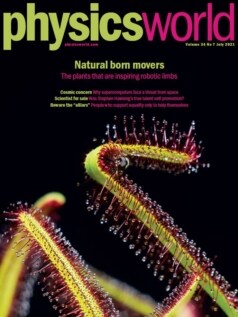
With 29 bones, 123 ligaments and 34 muscles pulling the strings, the human hand is a feat of nature’s engineering. It lets us write, touch, hold, feel and interact in exquisite detail with the world around us.
To replicate the wonders of the human hand, researchers in the field of “soft robotics” are trying to design artificial structures made from flexible, compliant materials the can be controlled and programmed by computers.
Trouble is, the hand is such a complex structure that it needs lots of computing power to be properly controlled. That’s a problem when developing prosthetic hands for people who have lost an arm in, say, an accident or surgery.
Designers seeking to make their structures move are, however, finding inspiration from a surprising source: the study of movement in plants. As Daniel Rayneau-Kirkhope explains in the July 2021 issue of Physics World magazine, one strange-looking plant – the Cape sundew – could hold the key to soft, robotic limbs.
If you’re a member of the Institute of Physics, you can read the whole of Physics World magazine every month via our digital apps for iOS, Android and Web browsers. Let us know what you think about the issue on Twitter, Facebook or by e-mailing us at pwld@ioppublishing.org.
For the record, here’s a run-down of what else is in the issue.
• Beware of the “alliars” – While some people claim to want to support under-represented groups, Anya Lawrence says it can be difficult to determine whether they have the right motives
• Bridging the language divide – Pruthvi Mehta says more support should be given to non-native English-speaking scientists who can feel isolated and disadvantaged in what to them is an unfair system
• Tax breaks – In the second of a series of articles on how to start and fund a business, James Mckenzie looks at government tax incentives, which can be more useful than they first sound
• Vaccination reluctance – Robert P Crease explores the range of factors that turned him from vaccine sceptic to believer
• Replicating how plants move – Once studied by Charles Darwin, the Venus flytrap is perhaps the most famous plant that moves at high speed. But as Daniel Rayneau-Kirkhope explains, researchers are still unearthing new scientific insights into plant motion, which could lead to novel, bio-inspired robotic structures
• Supercomputers face a cosmic challenge – Fast neutrons from cosmic-ray showers can cause significant errors in supercomputers. But by measuring the scale of the problem, physicists hope not only to make such devices less prone to cosmic corruption but also protect everything from self-driving cars to quantum computers, as Rachel Brazil finds out

Topological fluids, the proton radius and art and science: the June 2021 issue of Physics World magazine is now out
• How to spark an interest – Rick Marshall shares his advice for giving an inspiring and engaging presentation about physics to pre-university school students
• It’s the little things – Angela Saini and her son Aneurin review Nano: the Spectacular Science of the Very (Very) Small by Jess Wade, illustrated by Melissa Castrillon
• No man is an island – Chanda Prescod-Weinstein reviews Helgoland by Carlo Rovelli
• Stephen Hawking: cosmic commodity – Laura Hiscott reviews Hawking Hawking: the Selling of a Scientific Celebrity by Charles Seife
• Making the switch – Changing career path can be daunting but there are big rewards for those who are brave enough to switch. M S Zobaer describes his unexpected journey from dusty plasmas to neuroscience
• Ask me anything – Mariya Lyubenova is an astronomer researching galaxy evolution at the European Southern Observatory (ESO). She is also head of media relations at ESO
• Sporting chance – With the Olympic Games due to get under way in Tokyo this month, Laura Hiscott brings you 10 physics-related sporting questions about the 10 different events in the decathlon – one of the highlights of the athletics programme.



